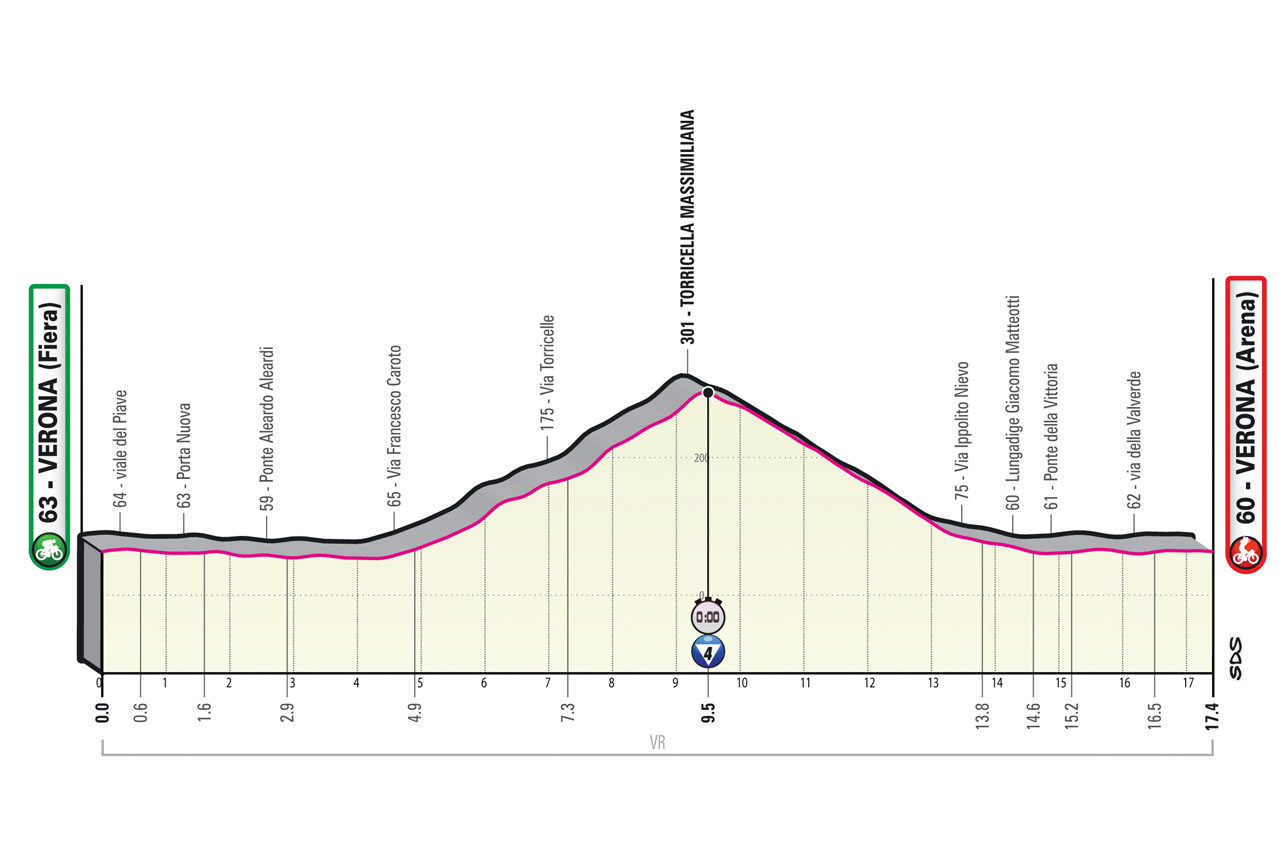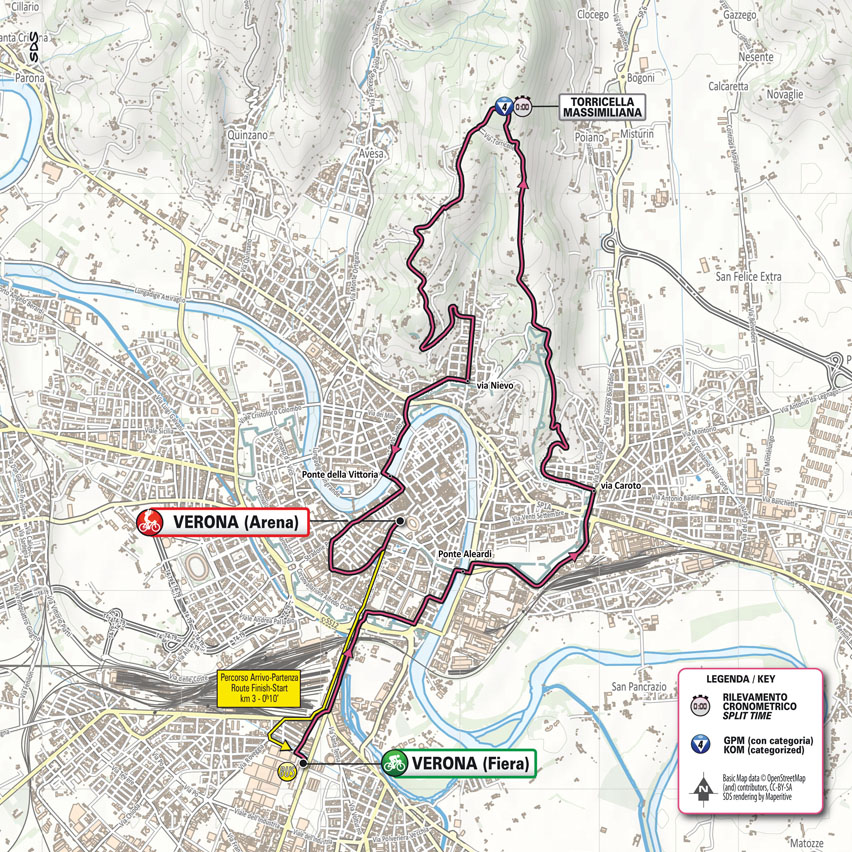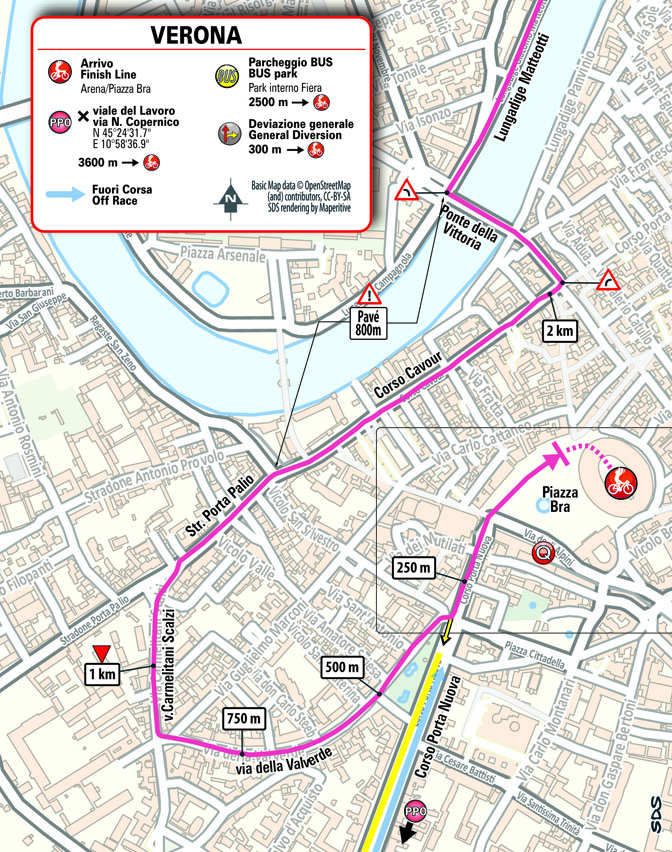profile
map
technical info
The route
An individual time trial on the Torricelle Circuit (the same as in the World Championships), covered counter-clockwise. The first part is on broad, straight boulevards, followed by an ascent sloping for 4.5 km at 5% in a series of steps, on narrower roadway. Split time is taken past the Torricella Massimiliana summit. The route then descends for 4 km, still on wide and straight roads. The last 3 km along the city streets, with some sharp bends, lead all the way to the finish in Piazza Bra and the Verona Arena.
Final kilometres
The final kilometres are on broad, straight urban avenues. The final time is taken in Piazza Bra, before entering the Arena. The home straight is 150 m long, on 6.5 m wide asphalt road.
start / finish
final kilometres
itinerary timetable
tourist info
Host city:
Verona
Overview
Origin: regarding the name of the city there are more than one theory. The most reliable is that the name Verona comes from the union of three ancient words, which mean: The city of the Veneto Region on the river.
The relations between Rome and Verona began around the third century BC, when centuries of great splendor began during which Verona, Roman city, was rebuilt within the loop of the river Adige. Its important ford was replaced by two bridges, Ponte Pietra and Ponte Postumio. During the Roman age Verona was a political and commercial venue of great importance, whose magnificent traces are still visible nowadays. An interesting, even if less known, aspect of the city are the ancient city walls, many parts of which are still preserved in excellent conditions. In 1136 AD Verona became fully a Municipality.
The city is well known also because it was land and crossroads of great poets and artists. Among the most famous: Shakespeare, who set the tragedy of the two lovers Romeo and Juliet within the Scaliger walls; Dante Alighieri, who lived many years of his life in exile in the Scaliger city as a guest of the Cangrande family and Paolo Caliari, called the Veronese, great painter of the Renaissance period.
Speciality food
Verona has a rich food culture, heritage of its thousand-year old local agriculture and plenty of DOP raw materials.
The most typical main dishes of the city are: pasta e fasoi, bigoli con le sarde, gnocchi and nodini di Valeggio.
The rice, grown in the lowlands of Verona, is the basic ingredient of many dishes: risotto al radicchio and Amarone wine, riso al tastasal or with peas.
Among the typical second courses it is worth mentioning: pastisada de caval and bollito with pearà (a typical sauce of Verona used to accompany meat).
Regarding the desserts, in addition to the famous pandoro, there are others which are typcal of the local cuisine: Nadalin, crostoli and the fritole of Carnival.
Rich is also the production of cheese and sausages. The Monte Veronese is certainly the most important, but there are many other type of cheese produced in the malghe della Lessinia (mountain huts), as well as typical cold cuts, like the soppressa all’aglio.
Last but not least the production of oil, from Garda lake to Valpolicella: both productions are certified DOP.
Drinks
Verona, rich of hills adorned with vineyards spreading from east to west, boasts a remarkable production of famous wines, which are exported all over the world.
Five are the DOCG labels: Amorone, Bardolino Superiore, Recioto della Valpolicella, Recioto Soave and Soave Superiore.
Among the 14 DOC wines it is worth mentioning: Bardolino, Bianco di Custoza, Valpolicella Ripasso, Soave and Lugana.
Main sights
Verona, UNESCO World Heritage city, boasts a thousand-year old city centre of great artistic and cultural interest. Its very heart is Piazza Bra, in the middle of which the Arena stands out: the Amphitheatre is famous all over the world being home to the Opera Festival, concerts and international events.
Walking along the typical streets, among which Via Mazzini, the main shopping street, Piazza delle Erbe can be reached: it is the ancient Roman Forum where most of the economic, political and social activities used to take place. Nowadays it is still venue of the city market and also of evening drinks and nightlife.
The square is dominated by the Torre dei Lamberti, 84 metres high: from its top a breathtaking view of the city can be enjoyed. Also from here the two main Roman streets started: the Cardo and the Decumanus Maximus, the last corresponding, as for Verona, to the Via Postumia itself; they are nowadays still visible. A few steps from here there are Juliet’s House, with its famous balcony, and the more hidden Romeo’s House. The other iconic attractions of Verona are: piazza dei Signori, Arche Scaligere, Castelvecchio, Roman Theatre and the Cathedral. A city centre of great artistic and cultural interest, lapped by the water of the river Adige.
Verona
Overview
Origin: regarding the name of the city there are more than one theory. The most reliable is that the name Verona comes from the union of three ancient words, which mean: The city of the Veneto Region on the river.
The relations between Rome and Verona began around the third century BC, when centuries of great splendor began during which Verona, Roman city, was rebuilt within the loop of the river Adige. Its important ford was replaced by two bridges, Ponte Pietra and Ponte Postumio. During the Roman age Verona was a political and commercial venue of great importance, whose magnificent traces are still visible nowadays. An interesting, even if less known, aspect of the city are the ancient city walls, many parts of which are still preserved in excellent conditions. In 1136 AD Verona became fully a Municipality.
The city is well known also because it was land and crossroads of great poets and artists. Among the most famous: Shakespeare, who set the tragedy of the two lovers Romeo and Juliet within the Scaliger walls; Dante Alighieri, who lived many years of his life in exile in the Scaliger city as a guest of the Cangrande family and Paolo Caliari, called the Veronese, great painter of the Renaissance period.
Speciality food
Verona has a rich food culture, heritage of its thousand-year old local agriculture and plenty of DOP raw materials.
The most typical main dishes of the city are: pasta e fasoi, bigoli con le sarde, gnocchi and nodini di Valeggio.
The rice, grown in the lowlands of Verona, is the basic ingredient of many dishes: risotto al radicchio and Amarone wine, riso al tastasal or with peas.
Among the typical second courses it is worth mentioning: pastisada de caval and bollito with pearà (a typical sauce of Verona used to accompany meat).
Regarding the desserts, in addition to the famous pandoro, there are others which are typcal of the local cuisine: Nadalin, crostoli and the fritole of Carnival.
Rich is also the production of cheese and sausages. The Monte Veronese is certainly the most important, but there are many other type of cheese produced in the malghe della Lessinia (mountain huts), as well as typical cold cuts, like the soppressa all’aglio.
Last but not least the production of oil, from Garda lake to Valpolicella: both productions are certified DOP.
Drinks
Verona, rich of hills adorned with vineyards spreading from east to west, boasts a remarkable production of famous wines, which are exported all over the world.
Five are the DOCG labels: Amorone, Bardolino Superiore, Recioto della Valpolicella, Recioto Soave and Soave Superiore.
Among the 14 DOC wines it is worth mentioning: Bardolino, Bianco di Custoza, Valpolicella Ripasso, Soave and Lugana.
Main sights
Verona, UNESCO World Heritage city, boasts a thousand-year old city centre of great artistic and cultural interest. Its very heart is Piazza Bra, in the middle of which the Arena stands out: the Amphitheatre is famous all over the world being home to the Opera Festival, concerts and international events.
Walking along the typical streets, among which Via Mazzini, the main shopping street, Piazza delle Erbe can be reached: it is the ancient Roman Forum where most of the economic, political and social activities used to take place. Nowadays it is still venue of the city market and also of evening drinks and nightlife.
The square is dominated by the Torre dei Lamberti, 84 metres high: from its top a breathtaking view of the city can be enjoyed. Also from here the two main Roman streets started: the Cardo and the Decumanus Maximus, the last corresponding, as for Verona, to the Via Postumia itself; they are nowadays still visible. A few steps from here there are Juliet’s House, with its famous balcony, and the more hidden Romeo’s House. The other iconic attractions of Verona are: piazza dei Signori, Arche Scaligere, Castelvecchio, Roman Theatre and the Cathedral. A city centre of great artistic and cultural interest, lapped by the water of the river Adige.



















































































































